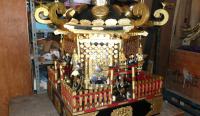Ten years ago, I took part in an event celebrating the 400th anniversary of Tokaido, in which I got deeply involved in mikoshi, portable shrine. In 1601, Ieyasu Tokugawa, the first shogun of the Edo government, introduced a regular service system for posting stations there, which played an important role in economic and cultural exchange between east and west Japan. The then construction ministry began a project called Tokaido Renaissance, and 53 post stations did various events with it; I was taking charge of Shinagawa’s event through a year, and we presented united carrying miniature shrines as its main event, mobilising 100,000 people. I remember that a bridge over Meguro River shook as if it bent because of the crowd gathered to see mikoshi. I asked local people what they do when mikoshi is broken. They said, “A great craftsman in Tochigi will have it repaired”.
This time, I visited Hohjudo Co., Ltd. to meet Mr Seiji Ogawa. Although nowadays he has been busy with an interview of a Japanese TV programme, this great craftsman told me about mikoshi and his job.
First of all, mikoshi is a palanquin for Shinto gods to be used for their spirits to temporarily subside when being carried to shrines in Shinto festivals. In other words, it is a vehicle for Gods. Many good craftsmen came to Tochigi long time ago as they were impressed by the constriction of Nikko Tosho-gu, which took only three years to complete. They are said to be the basis of Tochigi’s craftsmanship, and making mikoshi is one of the things they have since continued there. Hohjudo is among such historic carpenter families, dedicating to the job.
Mikoshi is attractive with a kind of magical power and changes consciousness of people carrying it at once. Indeed, it feels good to carry such a heavy object (1t) with many people. Because it is a Shinto ritual, it has strict rules and manners. But I think that nothing in Japan is as spiritual as mikoshi. We may be carrying invisible gods with us unconsciously.
Let me tell you how many people got involved in 13 mikoshi in Shinagawa’s event I explained earlier. When people to carry mikoshi, helpers and spectators all gathered, the crowd became as large as the National Stadium full of people. It had the ability to pull in massive crowds. Having managed it almost by myself has since been very helpful for my life.
I would say that hohjudo is the Japan’s best mikoshi producer, earning respect from persons involved. But it is not widely known that mikoshi has a collective sport aspect; in a tournament organised by the Japan Mikoshi Association, Mr Ogawa is a judge for years to mark voice, timing and unity. The prize of hohjudo is awarded to winners.
I heard a good story on mikoshi from him. A police man asked him to make a mikoshi, using his sugar-bowl savings. The craftsman produced one for him, which is now kept in his police station.
In the process of producing mikoshi, he uses many chisels and planes that he makes himself. I asked to him, “What about the drawing?” He said that he does not use it. Instead, there is a unique measuring stick, by which he can understand the size quickly. I couldn’t at all.
When he was invited from New Zealand to perform carrying of miniature shrines there, a foreign correspondent watched it from the sky and put his impression this way: The Gods of Land and Sky are interacting with each other, and people are supporting them from below. That’s very clever.

Ryo Kubota is a staff writer at Transpheric Management in Tokyo as well as a freelance writer. He has covered Sports for the Nippon Newspaper Company in Tokyo and teaches at a private tutoring school in Iruma, Japan. Having studied in both Tokyo and England in the areas of sociology, he has a keen interest in the world at large.









